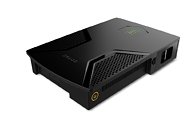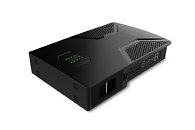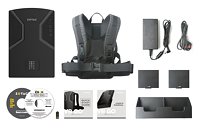Raevenlord
News Editor
- Joined
- Aug 12, 2016
- Messages
- 3,755 (1.21/day)
- Location
- Portugal
| System Name | The Ryzening |
|---|---|
| Processor | AMD Ryzen 9 5900X |
| Motherboard | MSI X570 MAG TOMAHAWK |
| Cooling | Lian Li Galahad 360mm AIO |
| Memory | 32 GB G.Skill Trident Z F4-3733 (4x 8 GB) |
| Video Card(s) | Gigabyte RTX 3070 Ti |
| Storage | Boot: Transcend MTE220S 2TB, Kintson A2000 1TB, Seagate Firewolf Pro 14 TB |
| Display(s) | Acer Nitro VG270UP (1440p 144 Hz IPS) |
| Case | Lian Li O11DX Dynamic White |
| Audio Device(s) | iFi Audio Zen DAC |
| Power Supply | Seasonic Focus+ 750 W |
| Mouse | Cooler Master Masterkeys Lite L |
| Keyboard | Cooler Master Masterkeys Lite L |
| Software | Windows 10 x64 |
After announcing earlier this week the impending release of their VR Go backpack, ZOTAC has now made pricing details available: $1999 will net you the ability to strap a PC to your body so you can freely engage with enemies or friends alike in VR environments.
The ZOTAC VR GO can work autonomously for up to two hours, feeding on two Li-ion batteries rated at 95Wh (6600mAh). The batteries can be hot-swapped and charged separately, featuring a DC12V-out for powering the HTC Vive or Oculus Rift. When not in use as a backpack to play virtual reality games, the VR GO can be used like a normal desktop computer: its form-factor allows it to be placed on a desk either vertically or horizontally and all the ports will remain accessible. It isn't very heavy, either, though at 4.95 kilograms, your mileage may vary.




For that price, you get a pretty high-specced PC with Windows 10 Home pre-installed, sporting an Intel Core i7 6700T (2.8 GHz base, up to 3.6 GHz turbo), the mentioned NVIDIA GTX 1070, 16 GB of DDR4-2133 memory installed (upgradable up to 64 GB), a 240 GB M.2 SATA SSD (with one extra, unpopulated 2.5" SATA bay) and a 3-in-1 card reader (SD/SDHC/SDXC), with the hardware being both passively (with heatsinks) and actively (with fans) cooled for your bodily (and hardware) comfort.
With regards to I/O, you have your usual headphone and microphone ports, as well as 6x USB 3.0 ports, dual Gigabit LAN (powered by Realtek), Wi-Fi 802.11ac/b/g/n as well as Bluetooth on the 4.2 protocol. The GTX 1070 powering it means you can use up to four displays (should you choose to use your backpack-PC as a desktop-PC), with the VR Go sporting 3x HDMI 2.0 (needed for your VR enabler of choice) as well as 2x DisplayPort 1.3 ports.
View at TechPowerUp Main Site
The ZOTAC VR GO can work autonomously for up to two hours, feeding on two Li-ion batteries rated at 95Wh (6600mAh). The batteries can be hot-swapped and charged separately, featuring a DC12V-out for powering the HTC Vive or Oculus Rift. When not in use as a backpack to play virtual reality games, the VR GO can be used like a normal desktop computer: its form-factor allows it to be placed on a desk either vertically or horizontally and all the ports will remain accessible. It isn't very heavy, either, though at 4.95 kilograms, your mileage may vary.




For that price, you get a pretty high-specced PC with Windows 10 Home pre-installed, sporting an Intel Core i7 6700T (2.8 GHz base, up to 3.6 GHz turbo), the mentioned NVIDIA GTX 1070, 16 GB of DDR4-2133 memory installed (upgradable up to 64 GB), a 240 GB M.2 SATA SSD (with one extra, unpopulated 2.5" SATA bay) and a 3-in-1 card reader (SD/SDHC/SDXC), with the hardware being both passively (with heatsinks) and actively (with fans) cooled for your bodily (and hardware) comfort.
With regards to I/O, you have your usual headphone and microphone ports, as well as 6x USB 3.0 ports, dual Gigabit LAN (powered by Realtek), Wi-Fi 802.11ac/b/g/n as well as Bluetooth on the 4.2 protocol. The GTX 1070 powering it means you can use up to four displays (should you choose to use your backpack-PC as a desktop-PC), with the VR Go sporting 3x HDMI 2.0 (needed for your VR enabler of choice) as well as 2x DisplayPort 1.3 ports.
View at TechPowerUp Main Site
Last edited:





